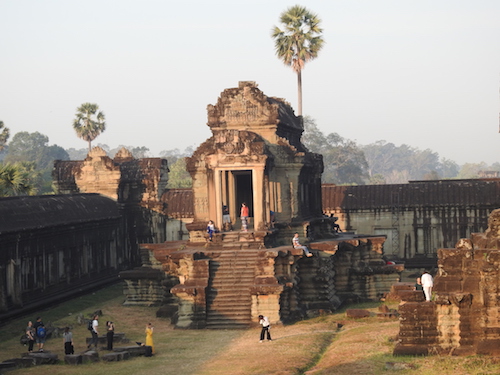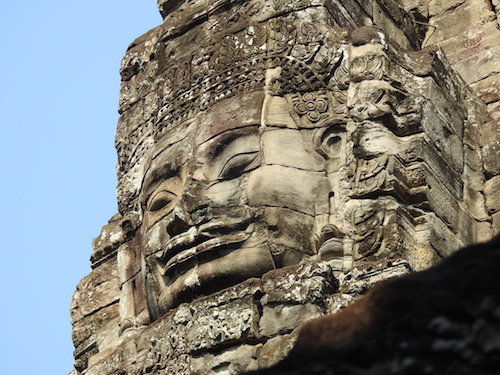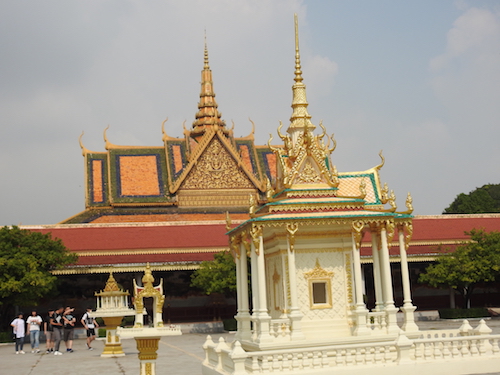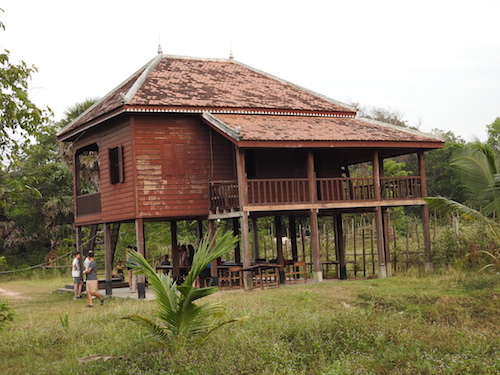 I’m a little nonplussed when my tour guide in Cambodia tells me he was once a member of the Khmer Rouge.
I’m a little nonplussed when my tour guide in Cambodia tells me he was once a member of the Khmer Rouge.
What, the brutal dictatorship of the 1970s that slaughtered more than two million of its own people? That wiped out education, money and religion, and forced people out of the cities to farm the land, where thousands more died of starvation? The ones that killed your father? Yes, says Heng Seng Hok, that’s them.
Hok was only 13 when he was forced to join the murderous regime that had supposedly been overthrown by then, but was still a deadly guerrilla force operating from the jungle. Hok later escaped to become a temple boy in Siem Reap, and like all older Cambodians, he has extraordinary tales to tell.
The country is still working to rebuild itself after those four bloody years, with its recovery helped by an influx of dollars as tourists return to admire the astonishing temple of Angkor Wat. It’s as magnificent as Machu Picchu, as intriguing as the Taj Mahal, and a great deal less crowded than either. It’s also just one of more than a hundred temples in the world’s largest archaeological site, displaying the skills and opulence of an empire that thrived from AD 802 to 1432.
 One morning I caught a tuk-tuk at 4.30am to see Angkor Wat’s elaborate towers tinged pink and reflecting beautifully in a lake at sunrise. The complex is vast, with a moat, entrance gates, and an 800-meter long corridor intricately decorated with bas-reliefs. Pity the stonemasons, who must have carved one warrior then realised there were still several thousand more to go. It reputedly occupied 300,000 craftsmen for 30 years and it’s utterly mindboggling.
One morning I caught a tuk-tuk at 4.30am to see Angkor Wat’s elaborate towers tinged pink and reflecting beautifully in a lake at sunrise. The complex is vast, with a moat, entrance gates, and an 800-meter long corridor intricately decorated with bas-reliefs. Pity the stonemasons, who must have carved one warrior then realised there were still several thousand more to go. It reputedly occupied 300,000 craftsmen for 30 years and it’s utterly mindboggling.
But my favourite temple was Bayon, built in the 12th century with 216 giant faces smiling enigmatically down from 54 towers. Another showstopper is Ta Prohm, where you expect Indiana Jones to swing past on a creeper, as the jungle has reclaimed the site and aerial roots of giant banyan trees inextricably embrace the stonework.
Cambodia has plenty of other drawcards too, but it’s less developed than its neighbours Vietnam and Thailand. You need to be a traveller, rather than a tourist, accepting rough roads and broken pavements, squat toilets and the dismaying amount of litter that mars its streets and beaches.
 Visiting Cambodia is also helping its people build their future, and not only because of the money you spend. Many former Khmer Rouge leaders still hold positions of power, Hok explained, which is why so few have been brought to justice. The perpetrators argue that the past must be left in the past, but with the world now watching, at least their atrocities can’t be repeated, he hopes.
Visiting Cambodia is also helping its people build their future, and not only because of the money you spend. Many former Khmer Rouge leaders still hold positions of power, Hok explained, which is why so few have been brought to justice. The perpetrators argue that the past must be left in the past, but with the world now watching, at least their atrocities can’t be repeated, he hopes.
Their legacy certainly lives on. Cambodia was the most land-mined country in the world, and numerous NGOs are retraining people who were maimed. Seeing Hands massage centres are staffed by the blind, and my masseur at Siem Reap - blinded by a landmine at 14 - delivered a vigorous work-over using fingers, fists and elbows to knead my knotted muscles into submission. An hour cost $8, and it was so good I sought out Seeing Hands centres in other towns.
Siem Reap has become a party town for temple tourists, with a night market, a Hard Rock Cafe and Pub Street full of bars next to stalls selling t-shirts for $1.
 For a more authentic experience I spent a night in a homestay at Sambor Prei Kuk, a tiny village where families welcome tourists into traditional homes built on stilts. The open ground below is used for living and the rooms above for sleeping. Our supper was chicken soup, ginger pork, rice, noodles and vegetables followed by vivid purple dragon fruit. Then we took turns in the basic bathroom, sloshing water over ourselves from a trough before bedding down on thin mattresses under mosquito nets in the communal space upstairs. The humid air was barely ruffled by a fan proudly installed three weeks earlier when the house finally received electricity. I counted the hours away, helped by a cock crowing throughout the night.
For a more authentic experience I spent a night in a homestay at Sambor Prei Kuk, a tiny village where families welcome tourists into traditional homes built on stilts. The open ground below is used for living and the rooms above for sleeping. Our supper was chicken soup, ginger pork, rice, noodles and vegetables followed by vivid purple dragon fruit. Then we took turns in the basic bathroom, sloshing water over ourselves from a trough before bedding down on thin mattresses under mosquito nets in the communal space upstairs. The humid air was barely ruffled by a fan proudly installed three weeks earlier when the house finally received electricity. I counted the hours away, helped by a cock crowing throughout the night.
During my tour I cruised on the mighty Mekong Rover, wimped out of eating fried tarantulas, snorkelled in the warm sea off the jagged coastline, and cycled through villages meeting rice wine bootleggers. I rode the Bamboo Train too, sitting on an open platform of bamboo and whizzing along a railway track at a merry rate. It originally shifted sacks of rice from the countryside, and now earns its keep by entertaining tourists.
 I ended back in Phnom Penh, with hotels and bars, a riverside promenade, bustling markets, and the exquisite Royal Palace, with pointy roofs, silver floor tiles and peaceful gardens. Then there’s Tuol Sleng Prison Museum and the Killing Fields of Choeung Ek, slamming you right back to the recent past.
I ended back in Phnom Penh, with hotels and bars, a riverside promenade, bustling markets, and the exquisite Royal Palace, with pointy roofs, silver floor tiles and peaceful gardens. Then there’s Tuol Sleng Prison Museum and the Killing Fields of Choeung Ek, slamming you right back to the recent past.
Tuol Sleng was a school until the Khmer Rouge banned education and turned it into one of 5,000 prisons. More than 20,000 people were tortured in Tuol Sleng alone, then taken to Choeung Ek to be murdered and shoved into mass graves.
There are countless Killing Fields sites, and as I followed the wooden path between mass graves, I saw some ragged clothes that had washed up in the heavy rains. I looked at Hok, and saw tears in his eyes as he told the story again.